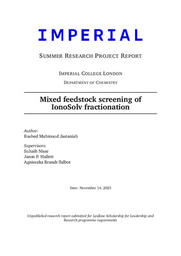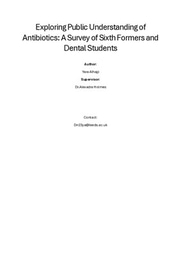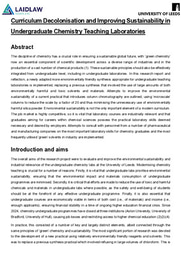Project Outline: Ionic liquid-based biomass fractionation

The effect of biomass variability on ionic liquid-based biomass fractionation
Supervisors:
Suhaib Nisar, Doctoral researcher , Department of Chemical Engineering, Imperial College London
Agnieszka Brandt-Talbot, Associate Professor in Sustainable Materials Chemistry, Department of Chemistry, Imperial College London
Jason P. Hallett, Professor of Sustainable Chemical Technology, Department of Chemical Engineering, Imperial College London
Project Background
ionoSolv is a novel method to fractionate lignocellulosic biomass and isolate its three constituent components- cellulose, hemicellulose and lignin- that was invented at Imperial College London's Hallett group in 2011. This is a safer, cost-effective and environmentally friendly solution that uses protic ionic liquids in contrast to legacy methods like organosolv that rely on toxic petrochemical-based organic solvents. Among many applications, the isolation of cellulose is an essential starting ingredient in the synthesis of biofuels that are more viable, economical and ecologically-friendly than competing candidates such as bioethanol.
ionoSolv's success has surpassed simple laboratory research and several Imperial College spinout companies, such as Lixea, utilise this process in their product development.
However, since its discovery, ionoSolv only took one type of feedstock at a time. ionoSolv has been tested on many different plant species (the feedstock), however, the effect of multiple feedstocks in the same batch are completely unknown.
Methodology
I am investigating the effect of mixing 2 biomasses whereas my collaborator is studying 3 using a different ionic liquid. Using JMP statistical discovery software, a design of experiments (DOE) will be set out to plan experimental runs to generate optimal results that will maximise the amount of information we can extract given the time available. ionoSolv will then be carried out on the samples based on DOE.
Compositional analysis (CA) is carried out to characterise products and determine whether varying biomass feedstocks has any effect on ionoSolv. The two main CA techniques employed are HSQC NMR and Near IR spectroscopy.
Based on observed effects, if any, results will then be used for mathematical modelling using Python programming language.
Objectives
Understanding this effect and modelling it mathematically will be a significant contribution to our academic understanding of biorefinery and, more importantly, paves way for future innovation in sustainable chemical technology allowing us to use ionoSolv dynamically for agricultural waste management and valorisation.





Please sign in
If you are a registered user on Laidlaw Scholars Network, please sign in